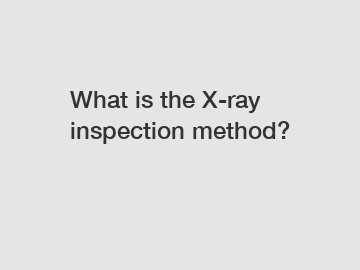What is the X-ray inspection method?
Imagine having the ability to see through solid objects and identify hidden details that the naked eye cannot perceive. While it may sound like something out of a science fiction movie, X-ray inspection is a technological marvel that allows us to do just that. In this blog, we will delve into the intricacies of the X-ray inspection method, exploring its uses, benefits, and how it works. So fasten your seatbelts as we embark on a journey through the world of X-rays!
1. A Closer Look at X-ray Inspection:
At its core, X-ray inspection involves the use of high-energy electromagnetic radiation, known as X-rays, to penetrate an object and create an image. Originally discovered by Wilhelm Conrad Roentgen in 1895, X-rays have since revolutionized numerous fields, from healthcare to aviation security, and non-destructive testing. This non-invasive technique enables the inspection and analysis of both organic and inorganic materials, providing valuable insight into their structure, composition, and integrity.

2. How Does X-ray Inspection Work?
X-ray inspection systems primarily consist of three key components: an X-ray source, a detector, and a processing unit. When an object is placed between the source and the detector, the X-rays pass through the material, with some being absorbed or deflected based on the density and atomic composition of the object. The varying intensities of the transmitted X-rays are then recorded by the detector, forming a digital image that reveals internal features and defects.
3. Wide Range of Applications:
X-ray inspection finds applications in a multitude of industries, where its unmatched capabilities provide invaluable assistance. In healthcare, X-rays are routinely used for diagnosing fractures, tumors, dental issues, and monitoring the progress of treatments. Industrial sectors leverage X-ray inspection to ensure the quality and reliability of products, detect manufacturing defects, and inspect critical components. Furthermore, the technique is instrumental in transportation safety, preventing illegal smuggling of goods, and in research and archaeology, aiding in the preservation and analysis of priceless artifacts.
4. Non-Destructive Testing:
One of the key advantages of X-ray inspection is its non-destructive nature. Unlike traditional testing methods that often necessitate the destruction of samples or objects, X-rays allow for the evaluation of internal structures without compromising the integrity of the item being inspected. This makes X-ray inspection particularly beneficial in situations where preserving the original state of the object or component is crucial, be it in art restoration, forensics, or the evaluation of delicate electronic devices.
5. Ensuring Safety and Security:
In various sectors, the X-ray inspection method plays a pivotal role in maintaining safety and security standards. For instance, at airports, luggage and cargo are scanned using X-ray systems to detect prohibited items, explosives, or other potential threats. Similarly, in the food industry, X-ray inspection helps identify foreign objects such as metal fragments, ensuring consumer safety. This method provides an additional layer of defense by identifying potential risks that are invisible to the human eye.
6. Technological Advancements:
Over the years, advancements in technology have led to the development of more sophisticated X-ray inspection systems. From dual-energy X-ray scanners that enhance material discrimination to computed tomography (CT) scanning, which provides three-dimensional imaging, the field has evolved significantly. These innovations have improved image quality, reduced scan times, enhanced accuracy, and expanded the range of applications for X-ray inspection.
7. Safety Measures:
While X-rays offer a multitude of benefits, it is crucial to address the potential risks associated with ionizing radiation. Strict safety measures, such as shielding, distance, limited exposure durations, and the use of personal protective equipment, are implemented to ensure the well-being of operators and those subjected to X-ray examination. Additionally, regulations and guidelines govern the use of X-ray inspection equipment to minimize radiation exposure to acceptable levels.
Conclusion:
The X-ray inspection method is a mesmerizing blend of science, technology, and ingenuity that empowers us to explore the invisible. From healthcare to industrial applications, X-ray inspection provides unparalleled insights into the inner workings of objects and materials, revolutionizing multiple industries in the process. As technology advances, we can expect even more remarkable discoveries and applications of this incredible tool that continues to push the boundaries of human capability. So next time you see an X-ray image, remember the wonders it holds within!
Disclaimer: The information provided in this blog is for educative purposes only. For any X-ray inspection or medical-related queries, consult a qualified professional.
For more information, please visit Zhengye Technology Co., Ltd., AOI PCB Machine, Automatic voltage and internal resistance test equipment.

Comments